service TOYOTA TUNDRA HYBRID 2023 Owner's Manual
[x] Cancel search | Manufacturer: TOYOTA, Model Year: 2023, Model line: TUNDRA HYBRID, Model: TOYOTA TUNDRA HYBRID 2023Pages: 618, PDF Size: 13.67 MB
Page 481 of 618
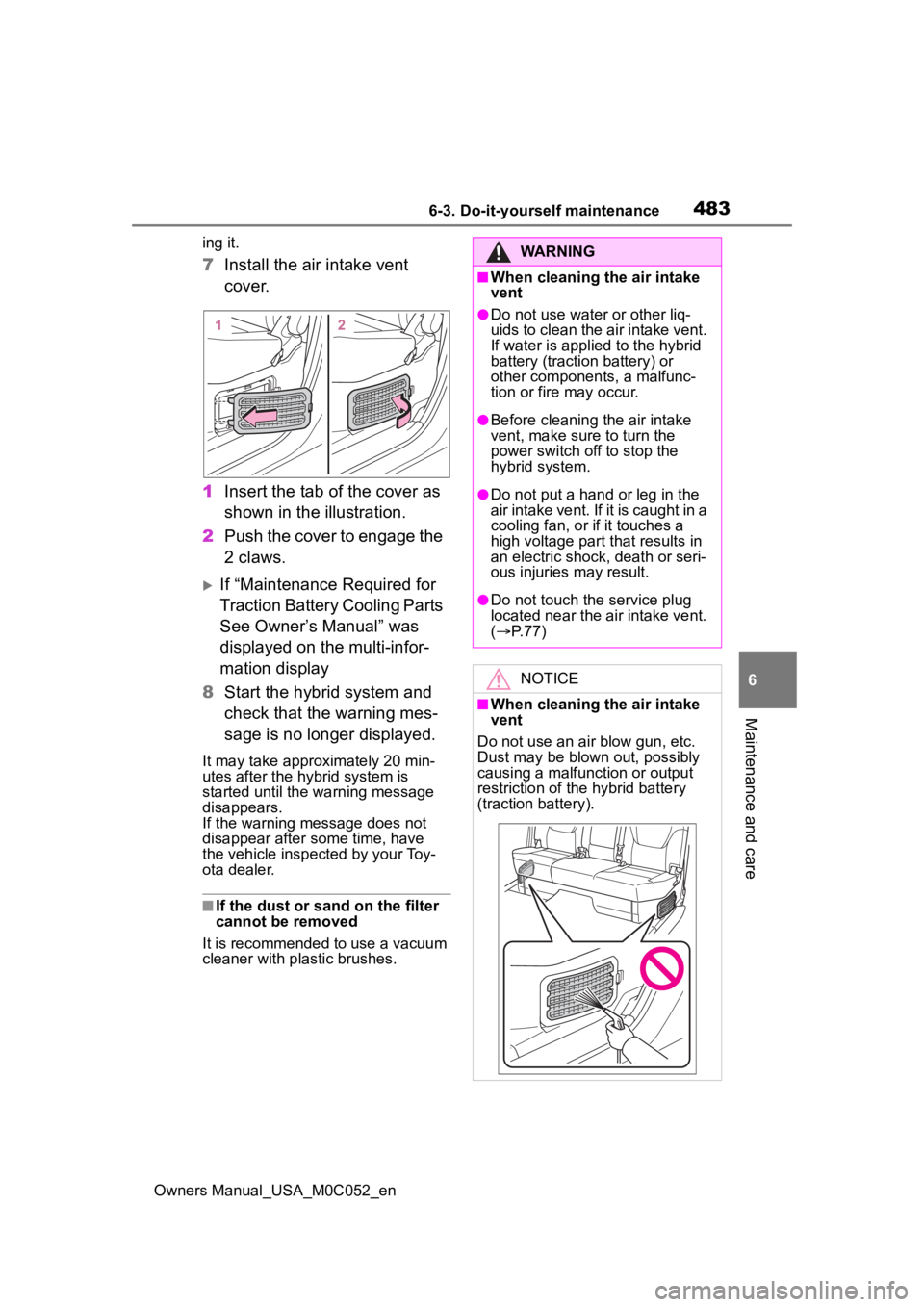
4836-3. Do-it-yourself maintenance
Owners Manual_USA_M0C052_en
6
Maintenance and care
ing it.
7 Install the air intake vent
cover.
1 Insert the tab of the cover as
shown in the illustration.
2 Push the cover to engage the
2 claws.
If “Maintenance Required for
Traction Battery Cooling Parts
See Owner’s Manual” was
displayed on the multi-infor-
mation display
8 Start the hybrid system and
check that the warning mes-
sage is no longer displayed.
It may take approximately 20 min-
utes after the hybrid system is
started until the warning message
disappears.
If the warning message does not
disappear after some time, have
the vehicle inspected by your Toy-
ota dealer.
■If the dust or sand on the filter
cannot be removed
It is recommended to use a vacuum
cleaner with plastic brushes.
WARNING
■When cleaning the air intake
vent
●Do not use water or other liq-
uids to clean the air intake vent.
If water is applied to the hybrid
battery (traction battery) or
other components, a malfunc-
tion or fire may occur.
●Before cleaning the air intake
vent, make sure to turn the
power switch off to stop the
hybrid system.
●Do not put a han d or leg in the
air intake vent. If it is caught in a
cooling fan, or if it touches a
high voltage part that results in
an electric shock, death or seri-
ous injuries may result.
●Do not touch the service plug
located near the air intake vent.
( P. 7 7 )
NOTICE
■When cleaning the air intake
vent
Do not use an ai r blow gun, etc.
Dust may be blown out, possibly
causing a malfunction or output
restriction of the hybrid battery
(traction battery).
Page 495 of 618
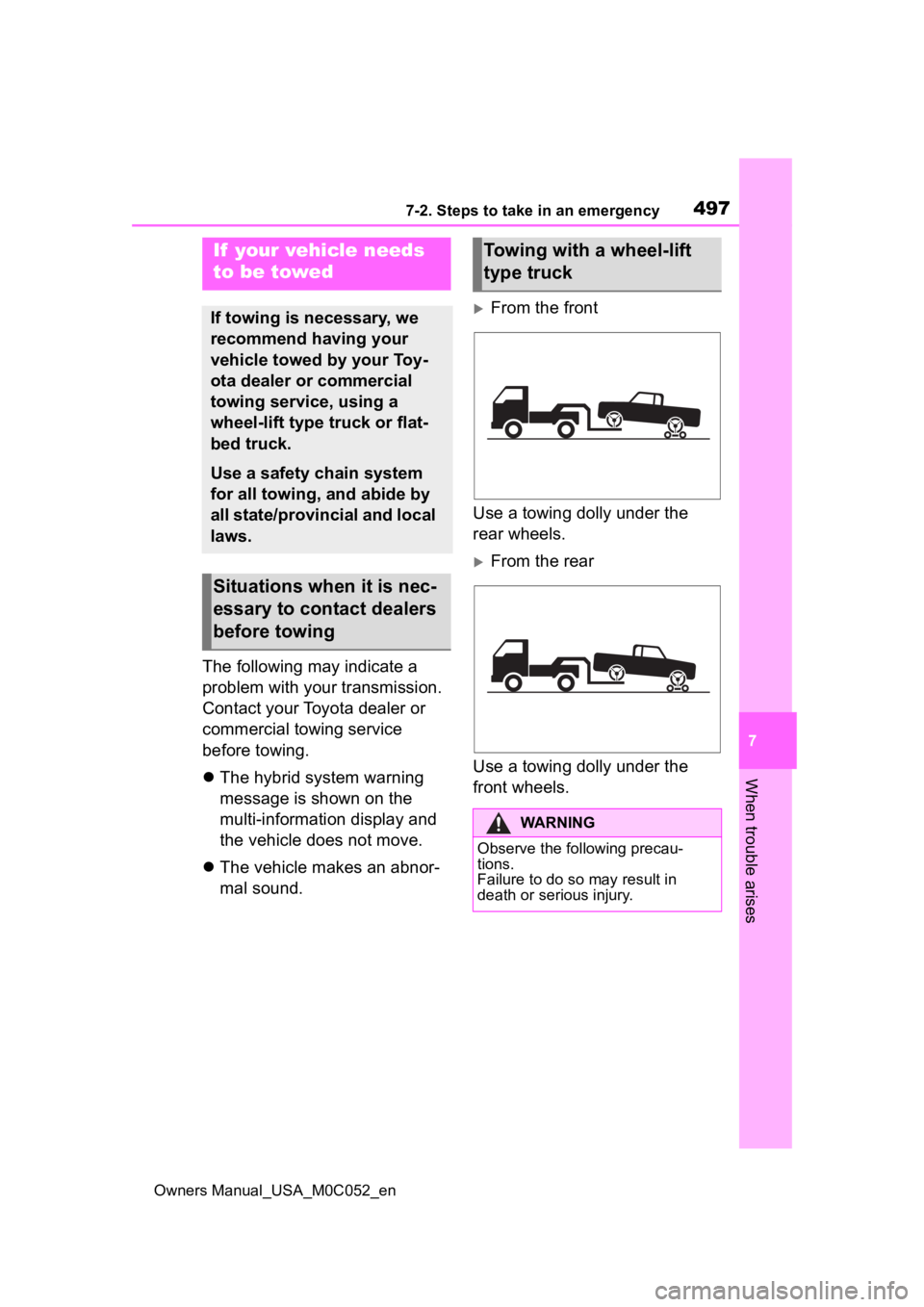
4977-2. Steps to take in an emergency
Owners Manual_USA_M0C052_en
7
When trouble arises
7-2.Steps to take in an emergency
The following may indicate a
problem with your transmission.
Contact your Toyota dealer or
commercial towing service
before towing.
The hybrid system warning
message is shown on the
multi-information display and
the vehicle does not move.
The vehicle makes an abnor-
mal sound.
From the front
Use a towing dolly under the
rear wheels.
From the rear
Use a towing dolly under the
front wheels.
If your vehicle needs
to be towed
If towing is necessary, we
recommend having your
vehicle towed by your Toy-
ota dealer or commercial
towing service, using a
wheel-lift type truck or flat-
bed truck.
Use a safety chain system
for all towing, and abide by
all state/provincial and local
laws.
Situations when it is nec-
essary to contact dealers
before towing
Towing with a wheel-lift
type truck
WARNING
Observe the following precau-
tions.
Failure to do so may result in
death or serious injury.
Page 497 of 618
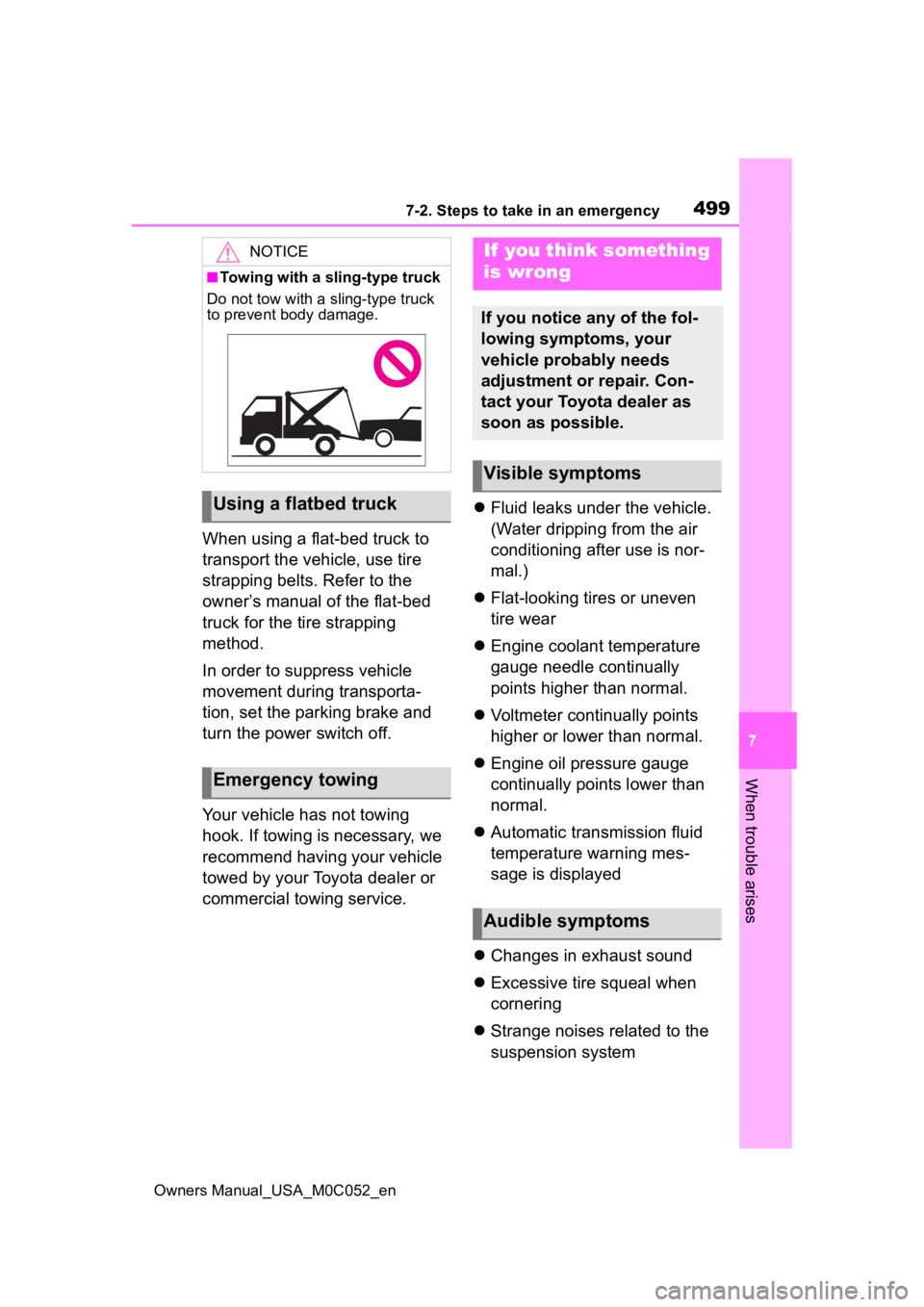
4997-2. Steps to take in an emergency
Owners Manual_USA_M0C052_en
7
When trouble arises
When using a flat-bed truck to
transport the vehicle, use tire
strapping belts. Refer to the
owner’s manual of the flat-bed
truck for the tire strapping
method.
In order to suppress vehicle
movement during transporta-
tion, set the parking brake and
turn the power switch off.
Your vehicle has not towing
hook. If towing is necessary, we
recommend having your vehicle
towed by your Toyota dealer or
commercial towing service.
Fluid leaks under the vehicle.
(Water dripping from the air
conditioning after use is nor-
mal.)
Flat-looking tires or uneven
tire wear
Engine coolant temperature
gauge needle continually
points higher than normal.
Voltmeter continually points
higher or lower than normal.
Engine oil pressure gauge
continually points lower than
normal.
Automatic transmission fluid
temperature warning mes-
sage is displayed
Changes in exhaust sound
Excessive tire squeal when
cornering
Strange noises related to the
suspension system
NOTICE
■Towing with a sling-type truck
Do not tow with a sling-type truck
to prevent body damage.
Using a flatbed truck
Emergency towing
If you think something
is wrong
If you notice any of the fol-
lowing symptoms, your
vehicle probably needs
adjustment or repair. Con-
tact your Toyota dealer as
soon as possible.
Visible symptoms
Audible symptoms
Page 522 of 618
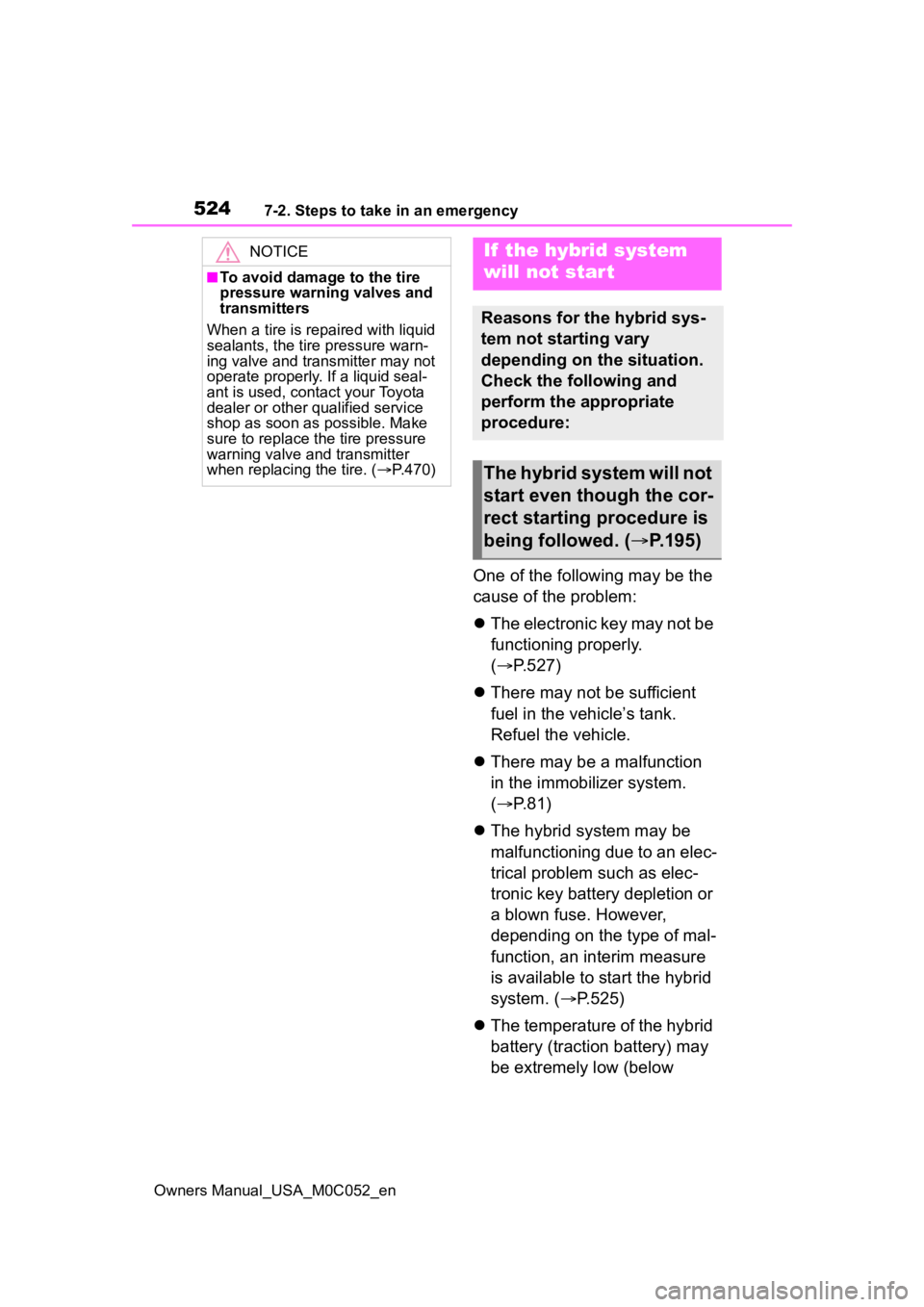
5247-2. Steps to take in an emergency
Owners Manual_USA_M0C052_en
One of the following may be the
cause of the problem:
The electronic key may not be
functioning properly.
( P.527)
There may not be sufficient
fuel in the vehicle’s tank.
Refuel the vehicle.
There may be a malfunction
in the immobilizer system.
( P.81)
The hybrid system may be
malfunctioning due to an elec-
trical problem such as elec-
tronic key battery depletion or
a blown fuse. However,
depending on the type of mal-
function, an interim measure
is available to start the hybrid
system. ( P.525)
The temperature of the hybrid
battery (traction battery) may
be extremely low (below
NOTICE
■To avoid damage to the tire
pressure warning valves and
transmitters
When a tire is repaired with liquid
sealants, the tire pressure warn-
ing valve and transmitter may not
operate properly. If a liquid seal-
ant is used, contact your Toyota
dealer or other qualified service
shop as soon as possible. Make
sure to replace the tire pressure
warning valve and transmitter
when replaci ng the tire. (P.470)
If the hybrid system
will not star t
Reasons for the hybrid sys-
tem not starting vary
depending on the situation.
Check the following and
perform the appropriate
procedure:
The hybrid system will not
start even though the cor-
rect starting procedure is
being followed. ( P.195)
Page 548 of 618
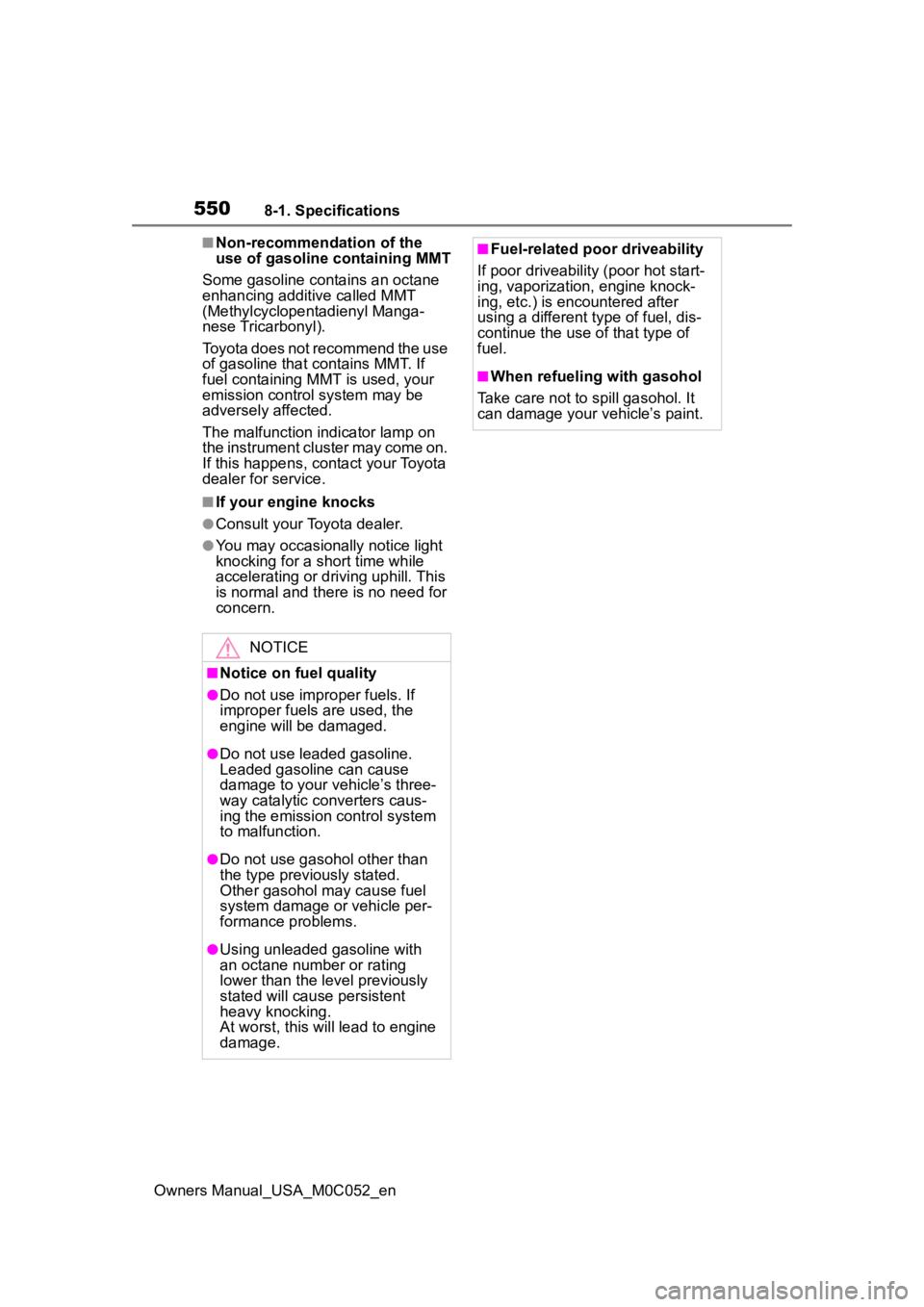
5508-1. Specifications
Owners Manual_USA_M0C052_en
■Non-recommendation of the
use of gasoline containing MMT
Some gasoline contains an octane
enhancing additive called MMT
(Methylcyclopentadienyl Manga-
nese Tricarbonyl).
Toyota does not recommend the use
of gasoline that contains MMT. If
fuel containing MMT is used, your
emission control system may be
adversely affected.
The malfunction indicator lamp on
the instrument cluster may come on.
If this happens, contact your Toyota
dealer for service.
■If your engine knocks
●Consult your Toyota dealer.
●You may occasionally notice light
knocking for a short time while
accelerating or dr iving uphill. This
is normal and there is no need for
concern.
NOTICE
■Notice on fuel quality
●Do not use impro per fuels. If
improper fuels are used, the
engine will be damaged.
●Do not use leaded gasoline.
Leaded gasoline can cause
damage to your vehicle’s three-
way catalytic converters caus-
ing the emission control system
to malfunction.
●Do not use gasohol other than
the type previously stated.
Other gasohol may cause fuel
system damage or vehicle per-
formance problems.
●Using unleaded gasoline with
an octane number or rating
lower than the l evel previously
stated will cause persistent
heavy knocking.
At worst, this will lead to engine
damage.
■Fuel-related poor driveability
If poor driveability (poor hot start-
ing, vaporization, engine knock-
ing, etc.) is encountered after
using a different type of fuel, dis-
continue the use of that type of
fuel.
■When refueling with gasohol
Take care not to spill gasohol. It
can damage your vehicle’s paint.
Page 552 of 618

5548-1. Specifications
Owners Manual_USA_M0C052_en
tion on uniform tire quality grad-
ing.
Your Toyota dealer will help answer
any questions you may have as you
read this information.
■DOT quality grades
All passenger vehicle tires must
conform to Federal Safety
Requirements in addition to
these grades. Quality grades
can be found where applicable
on the tire sidewall between
tread shoulder and maximum
section width.
For example: Treadwear 200 Trac-
tion AA Temperature A
■Treadwear
The treadwear grade is a com-
parative rating based on the
wear rate of the tire when tested
under controlled conditions on a
specified government test
course.
For example, a tire graded 150
would wear one and a half (1 - 1/2)
times as well on the government
course as a tire graded 100.
The relative perfo rmance of tires
depends upon the actual conditions
of their use. Performance may differ
significantly from the norm due to
variations in driving habits, service
practices and differences in road
characteristics and climate.
■Traction AA, A, B, C
The traction grades, from high-
est to lowest, are AA, A, B and
C, and they represent the tire’s
ability to stop on wet pavement as measured under controlled
conditions on specified govern-
ment test surfaces of asphalt
and concrete.
A tire marked C may have poor
traction performance.
Warning: The traction grade
assigned to this tire is based on
braking (straight ahead) traction
tests and does not include corner-
ing (turning) traction.
■Temperature A, B, C
The temperature grades are A
(the highest), B, and C, repre-
senting the tire’s resistance to
the generation of heat and its
ability to dissipate heat when
tested under controlled condi-
tions on a specified indoor labo-
ratory test wheel.
Sustained high temperature can
cause the material of the tire to
degenerate and reduce tire life, and
excessive temperature can lead to
sudden tire failure.
Grade C corresponds to a level of
performance which all passenger
car tires must meet under the Fed-
eral Motor Vehicle Safety Standard
No. 109.
Grades B and A represent higher
levels of performance on the labo-
ratory test wheel than the minimum
required by law.
Warning: The temperature grades
of a tire assume tha t it is properly
inflated and not overloaded.
Excessive speed, underinflation, or
excessive loading, either sepa-
rately or in combination, can cause
Page 601 of 618

Owners Manual_USA_M0C052_en
Alphabetical Index603
Road Sign Assist .................... 253
RSA (Road Sign Assist) ......... 253
S
Safety Connect ......................... 68
Seat belt reminder light ......... 507
Seat belts .................................. 29Adjusting the seat belt shoulder anchor height ....................... 33
Automatic Locking Retractor .. 31
Child restraint system installation ............................................. 55
Cleaning and maintaining the seat belt.............................. 445
Emergency Locking Retractor 31
How to wear your seat belt..... 30
How your child should wear the seat belt................................ 30
Pregnant women, proper seat belt use................................. 29
Reminder light and buzzer ... 507
Seat belt extender .................. 30
Seat belt pretensioners .......... 34
SRS warning light................. 502
Seat heaters ............................ 407
Seat position memory ............ 137
Seat ventilators ...................... 407
Seating capacity ............. 180, 541
Seats ................................ 133, 134 Adjustment ........................... 133
Adjustment precautions133, 134, 136
Child seats/child restraint system installation ............................ 53
Cleaning ............................... 445
Driving position memory....... 137
Folding down and returning the rear seatbacks.................... 134
Head restraints ..................... 140
Power easy access system .. 137
Properly sitting in the seat ...... 27
Seat heaters ......................... 407 Seat position memory...........137
Seat ventilators.....................407
Sensor Automatic headlight system . 211
Automatic High Beam system...........................................214
BSM (Blind Spot M onitor) .....268
Dynamic radar cruise control with full-speed range ..........225
Inside rear view mirror ..........145
Intuitive parking assist ..........274
LTA (Lane Tracing Assist) .....242
Parking Support Brake function (rear-crossing vehicles) ......268
Parking Support Brake function (static objects) ....................274
PCS (Pre-Collisio n System) .225
Radar sensor ........................225
Rain-sensing windshield wipers ...........................................220
RCTA (Rear Cross Traffic Alert) ...........................................268
Service plug ..............................76
Shift lever ................................201 Automatic transm ission ........200
If th e s hif t le ver ca n no t b e s hif te d from P .................................201
Shift lever light........................410
Shift lock system ....................201
Side airbags ..............................36
Side marker lights Light switch........................... 211
Replacing light bulbs ............490
Side mirrors Adjustment ...........................155
BSM (Blind Spot M onitor) .....267
Folding..................................156
Heaters .................................401
Mirror position me mory.........137
RCTA (Rear Cross Traffic Alert) ...........................................281
Side turn signal lights ............204